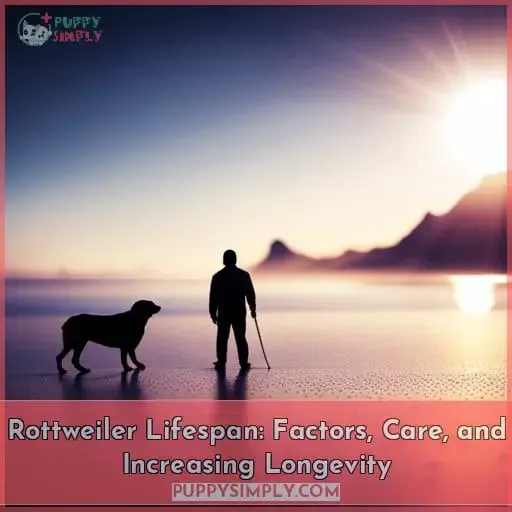This site is supported by our readers. We may earn a commission, at no cost to you, if you purchase through links.
 Imagine having a loyal companion by your side, one who brings joy and protection to your life. Enter the Rottweiler – a breed known for its strength, intelligence, and unwavering loyalty.
Imagine having a loyal companion by your side, one who brings joy and protection to your life. Enter the Rottweiler – a breed known for its strength, intelligence, and unwavering loyalty.
In this article, we will delve into the factors that influence the Rottweiler’s longevity and explore ways to increase their lifespan through proper care and nutrition. Get ready to unlock the secrets of maximizing your beloved Rottweiler’s years by understanding what it takes to ensure their well-being.
Table Of Contents
- Key Takeaways
- Rottweiler Lifespan
- Puppyhood (0-2 Years)
- Adulthood (2-7.5 Years)
- Seniorhood (7.5+ Years)
- Factors Influencing Rottweiler Lifespan
- Increasing the Lifespan of Your Rottweiler
- Sterilization and Lifespan
- Research on Rottweiler Lifespan
- Comparing Lifespan of Different Dog Breeds
- Tips for Promoting a Long and Healthy Life
- Frequently Asked Questions (FAQs)
- Are there any specific health issues that Rottweilers are prone to that can affect their lifespan?
- Are there any lifestyle factors that can influence a Rottweiler’s lifespan?
- How does the lifespan of a Rottweiler compare to other dog breeds?
- Is there any research being done on ways to extend the lifespan of Rottweilers?
- What are some tips for promoting a long and healthy life for a Rottweiler?
- Conclusion
Key Takeaways
- Rottweilers have an average lifespan of 8-10 years, with males tending to live slightly shorter lives than females.
- The leading causes of death in Rottweilers are cancer, inability to stand, and gastrointestinal disorders.
- Factors such as weight and body mass, genetics, environment, lifestyle, nutrition, and healthcare can influence a Rottweiler’s lifespan.
- To increase the lifespan of a Rottweiler, it is important to provide proper nutrition, regular exercise, avoid early neutering, and schedule regular vet check-ups.
Rottweiler Lifespan
The lifespan of Rottweilers can vary between 8-10 years, with males tending to live slightly shorter lives than females.
However, it’s worth noting that the longest living recorded Rottweiler lived just over 13 years old.
Factors Affecting Lifespan
To increase the lifespan of your Rottweiler, it’s important to understand the factors that can impact their longevity.
Factors such as:
- Weight and body mass
- Genetics and breeding
- Environment and lifestyle
- Nutrition and diet
- Healthcare and preventative care
all play a role in determining how long your Rottweiler will live.
By providing proper nutrition, regular exercise, veterinary care,and creating a healthy living environment,you can help ensure that your Rottweiler lives a long and happy life.
Oldest Recorded Rottweilers
You’ll be amazed by the impressive lifespans achieved by some Rottweilers, as they’ve truly stood the test of time.
- The oldest known Rottweiler lived to be 15 years and 9 months old.
- Another remarkable case is a Rottweiler that reached an age of 14 years and 11 months.
- A third notable example is a genetic study that identified certain markers associated with longevity in Rottweilers, suggesting potential ways to increase their lifespan even further through targeted breeding programs.
These exceptional examples highlight the potential for long life in this breed when provided with proper care and attention to their health needs.
Puppyhood (0-2 Years)
During the puppyhood stage of 0-2 years, Rottweilers experience rapid growth and development.
It’s important to provide them with proper nutrition and training during this critical period.
Rottweilers reach their maximum height around one year old, but don’t reach their full body weight until approximately two years old.
Growth and Development
During the puppyhood stage (0-2 years), your Rottweiler will experience rapid growth and development.
Their growth rate is most pronounced during this time, with significant increases in bone growth, weight gain, and teeth eruption as they go through teething.
This period is crucial for socialization and mental development. Proper training should also be implemented to ensure their overall well-being.
It’s important to monitor their health closely during these formative years to prevent conditions such as intervertebral disc disease or degenerative myelopathy later in life.
Importance of Proper Nutrition and Training
As your Rottweiler enters puppyhood (0-2 years), it’s crucial to provide proper nutrition and training to ensure healthy growth and development.
Establish a regular feeding schedule with high-quality food, ensuring the right balance of nutrients for their growing bodies.
Introduce them to a structured exercise routine that includes daily walks and playtime.
Puppy socialization is essential for their mental well-being, while obedience training helps establish good behavior patterns.
Begin crate training and housebreaking early on, along with grooming practices like dental care to promote overall health.
Adulthood (2-7.5 Years)
During the adulthood stage, which typically lasts from 2 to 7.5 years old, Rottweilers reach their full height and weight.
Male Rottweilers weigh around 110 lbs and stand at approximately 24-27 inches at the withers, while females weigh about 92 lbs and measure around 22-25 inches in height.
It’s important to adjust their nutrition and exercise routines accordingly to support a fully grown body during this stage of life.
Physical Characteristics of Adult Rottweilers
As your Rottweiler enters adulthood, their physical characteristics will reach their full potential.
- Weight: Male Rottweilers typically weigh around 110 lbs, while females weigh approximately 92 lbs.
- Height: Adult males measure between 24-27 inches at the withers, while females stand at about 22-25 inches.
- Muscle Mass: They’ve a well-developed muscular structure that reflects their strength and athleticism.
- Coat and Bone Structure: Adult Rottweilers possess a dense, double coat for protection and exhibit robust bone structure.
These physical attributes contribute to the distinctive appearance of adult Rottweilers as powerful yet elegant dogs in comparison to breeds like Great Danes or German Shepherds.
Maintaining Health and Wellness
To maintain the health and wellness of your adult Rottweiler, it’s important to provide proper nutrition and regular exercise.
Ensure that you schedule regular vet visits to keep track of their overall health.
A healthy diet tailored for their specific needs will help support their body’s functions.
Implement an exercise routine that includes daily walks or playtime to keep them physically active and mentally stimulated.
Proper grooming, such as brushing their coat regularly, can prevent skin issues.
Be mindful of potential spinal cord compression issues by avoiding activities that put strain on the back.
Epigenetic clock studies have shown promising results in understanding aging in dogs.
Seniorhood (7.5+ Years)
As your Rottweiler enters seniorhood, which typically starts around 7.5 years of age, you may notice signs of aging such as greying hair and difficulty standing.
It’s important to adjust their care accordingly to ensure they maintain a good quality of life during this stage.
Older Rottweilers may require adjustments in their diet and exercise routine, with an increased need for fiber to promote regular toileting and potential decreases in food intake and exercise requirements overall.
Signs of Aging in Rottweilers
When your Rottweiler reaches seniorhood (7.5+ years), you may start noticing signs of aging that require special attention and care.
- Weight loss: Senior Rottweilers often experience a decrease in appetite and can lose weight.
- Graying hair: Just like humans, Rottweilers’ hair may start turning gray as they age.
- Decreased activity: Older dogs tend to have less energy and mightn’t be as active as before.
- Joint pain: Arthritis is common in senior dogs, including Rottweilers, causing discomfort and stiffness.
These signs indicate the need for adjustments in diet, exercise routines, or even medical intervention if necessary to ensure your aging pet’s well-being.
Sources:
- Rotts-N-Kids – Common Health Issues [rott-n-kids.org]
- Aging Gracefully – What To Expect From Your Aging Dog [k9ofmine.com]
Adjusting Care for Senior Rottweilers
As your Rottweiler enters seniorhood, it’s important to adjust their care to ensure they remain healthy and comfortable in their later years.
Senior Rottweilers may experience:
- Decreased activity levels
- Require more rest periods
Increasing fiber intake can aid in regular toileting, while joint supplements help maintain mobility and reduce discomfort.
Additionally, providing cognitive enrichment activities can support mental stimulation and overall well-being for your aging Rottweiler.
Adjusting care for senior Rottweilers is crucial to promoting a long and fulfilling life for your beloved companion.
Factors Influencing Rottweiler Lifespan
There are several factors that can influence the lifespan of a Rottweiler.
Some of the leading causes of death in Rottweilers include:
- Cancer
- Inability to stand
- Gastrointestinal disorders
Additionally, diet plays a crucial role in their overall health and longevity, as well as regular exercise for cardiovascular health and weight management.
Leading Causes of Death
One of the leading causes of death in Rottweilers is cancer, which can significantly impact their lifespan.
Other factors that influence Rottweiler lifespan include:
- Heart disease
- Kidney failure
- Gastrointestinal disorders
- Old age
Understanding these leading causes of death is crucial for ensuring the longevity and well-being of your beloved pet.
Impact of Diet and Exercise
To maximize the lifespan of your Rottweiler, it’s crucial to provide them with a balanced diet and regular exercise.
Proper nutrition plays a vital role in their overall health and longevity. Consider their calorie needs based on age, weight, and activity level. Focus on high-quality food choices that support joint health, heart health, and weight management.
Alongside a nutritious diet, establish an exercise routine that promotes cardiovascular fitness while also considering their specific breed characteristics for optimal results.
| Impact of Diet | Impact of Exercise |
|---|---|
| – Provides essential | – Promotes cardiovascular |
| nutrients | fitness |
| – Supports joint | – Helps maintain |
| health | healthy body weight |
| – Contributes to heart | – Improves muscle tone |
| health | – Enhances mental |
| stimulation |
Increasing the Lifespan of Your Rottweiler
To increase the lifespan of your Rottweiler, it’s crucial to prioritize proper nutrition and regular exercise.
Providing a balanced diet that meets their nutritional needs will support their overall health and longevity.
Regular physical activity, such as daily walks or playtime, not only helps maintain a healthy weight but also promotes cardiovascular health.
By ensuring these essential factors are met, you can help increase the lifespan of your beloved Rottweiler companion.
Importance of Proper Nutrition
By providing proper nutrition, you can increase the lifespan of your Rottweiler. Here are four important factors to consider when it comes to their diet:
- Nutrient-dense foods:
- Choose high-quality dog food that’s specifically formulated for large breeds like Rottweilers.
- Look for options that contain a balanced mix of protein, carbohydrates, healthy fats, vitamins, and minerals.
- Feeding schedule:
- Establish a consistent feeding routine with regular meal times and portion sizes suitable for your dog’s age and weight.
- Supplements:
- Consider adding supplements such as omega-3 fatty acids or joint support formulas to promote overall health and address specific needs like joint mobility or skin/coat health.
- Raw diet or home-cooked meals:
- Some owners opt for raw diets or homemade meals prepared under veterinary supervision to ensure their Rottweiler receives optimal nutrition tailored to their individual needs.
Regular Exercise for Cardiovascular Health
To increase the lifespan of your Rottweiler, it’s essential that you regularly exercise them for optimal cardiovascular health.
Exercise provides numerous benefits, including improved heart function and weight management.
There are various types of exercise that can be beneficial for your Rottweiler, such as brisk walking, running, swimming, or playing fetch.
The intensity and duration of exercise should be appropriate for their age and fitness level.
Aim to provide at least 30 minutes to an hour of exercise daily to keep your Rottweiler healthy and extend their lifespan.
Sterilization and Lifespan
When considering the lifespan of your Rottweiler, it’s important to take into account the impact of sterilization.
Neutering, a common procedure in veterinary practices, has several benefits such as preventing unplanned litters and pyometra. However, concerns have been raised regarding potential side effects on health and longevity.
Limited data suggests that neutering before 4.5 years of age may have a negative impact on lifespan in Rottweilers compared to intact dogs or those neutered later in life.
Further research is needed to understand the reasons behind these findings and determine the optimal age for neutering Rottweilers.
Benefits of Neutering
Neutering your Rottweiler can have several benefits for their health and lifespan.
It can decrease the risk of certain cancers and diseases, such as testicular cancer and pyometra in females.
Neutering also reduces the increased risk of obesity that’s often associated with intact dogs.
However, it’s important to note that there may be potential side effects of neutering, such as an increased risk of certain neoplastic, musculoskeletal, and endocrinological conditions.
Further research is needed to fully understand the impact on lifespan in Rottweilers.
Potential Side Effects of Neutering
When considering the potential side effects of neutering your Rottweiler, it’s important to understand how this procedure can impact their lifespan.
Neutering has been associated with increased risk of certain neoplastic and musculoskeletal conditions in dogs. Additionally, there are concerns about elevated cancer risk and gastrointestinal disorders in neutered dogs.
Research suggests that early-age neutering may have a negative impact on the lifespan of Rottweilers, highlighting the need for further investigation into optimal age for sterilization procedures.
Research on Rottweiler Lifespan
Researchers have conducted studies on the relationship between neutering and lifespan in Rottweilers.
One study found that intact Rottweilers lived longer than those neutered before 1 year of age or 4.5 years of age, suggesting a potential negative impact on lifespan from early-age neutering.
Additionally, ongoing research such as The Dog Aging Project aims to understand the aging process in dogs and develop strategies to promote healthy longevity.
Studies on Neutering and Lifespan
If you’re wondering how neutering can impact the lifespan of your Rottweiler, recent studies on Rottweiler lifespans provide some insights.
These studies have found that intact Rottweilers tend to live longer than those that are neutered at a young age.
Neutering before 1 year of age was associated with a decrease in lifespan by 1.5 years, while neutering before 4.
Further research is needed to determine the optimal age for neutering and understand why it affects lifespan in this breed.
The Dog Aging Project
Join the Dog Aging Project to contribute to ongoing research on Rottweiler lifespan and aging. This project aims to understand the factors that influence dog aging and develop tools for accurate lifespan prediction.
One of these tools is the dog aging clock, which uses epigenetic changes in DNA to estimate a dog’s age. However, there are limitations and challenges in accurately predicting a dog’s lifespan due to variations among breeds, genetic factors, and environmental influences.
Funding from various sources supports this important research on understanding canine longevity.
| Research Methods | Accuracy | Limitations |
|---|---|---|
| Epigenetic Clock | Moderate | Breed Variability |
Environmental Factors
Genetic InfluencesComparing Lifespan of Different Dog Breeds
When comparing the lifespan of different dog breeds, one factor that stands out is the size of the dog.
Smaller dogs tend to live longer than larger dogs. This can be attributed to several factors, including:
- Genetic predisposition
- Metabolism rate
- Overall health maintenance
Understanding these differences in lifespan can help pet owners make informed decisions about their choice of breed and provide appropriate care for their furry companions throughout their lives.
Smaller Dogs Vs Larger Dogs
Now let’s compare the lifespan of smaller dogs versus larger dogs and see how it varies across different dog breeds.
- Larger dogs generally have a shorter lifespan compared to smaller dogs.
- Smaller dogs tend to live longer and age slower than their larger counterparts.
- Larger dogs age faster due to their rapid growth rate.
- Smaller dogs are often considered healthier overall, with fewer health issues associated with aging.
Factors Affecting Lifespan in Different Breeds
When comparing the lifespan of different dog breeds, it’s important to consider various factors that can influence how long they live. Breed size, genetics, exercise, diet, and neutering are all key elements to take into account.
Smaller breeds tend to live longer than larger ones due to their slower aging process. Additionally, genetics play a role in determining lifespan as certain breeds may be more prone to specific health conditions that can affect longevity.
Proper exercise and a balanced diet also contribute significantly to increasing the lifespan of dogs across different breeds.
Factors Affecting Lifespan in Different Breeds
When comparing the lifespan of different dog breeds like Rottweilers with other breed sizes such as smaller or medium-sized dogs like Beagles or Cocker Spaniels, there are several factors that need consideration beyond just breed size alone.
- Genetics play a significant role in determining an individual dog’s potential for longevity within its specific breed characteristics. Some genetic traits may predispose certain breeds towards developing health issues that could impact their overall lifespan.
- Exercise is another crucial factor affecting the lifespans of various dog breeds since regular physical activity helps maintain cardiovascular health and weight management—two critical aspects contributing towards increased life expectancy among dogs.
- Diet also plays an essential role in promoting good health and extending canine lifespans across diverse breed types by providing necessary nutrients while avoiding excessive calorie intake linked with obesity-related disorders often seen among overweight pets who consume unhealthy diets laden with processed ingredients lacking proper nutrition value required for optimal functioning throughout life stages ranging from puppyhood through adulthood into senior years when nutritional needs change over time accordingly based upon age-specific requirements dependent on growth rates varying between small versus large-breed puppies maturing at distinct rates typically reaching full adult stature around one year old vs two years respectively along differing timelines influenced by unique genetic makeups inherent within each particular type/breed category represented alongside variations arising outta individual genetic diversity within those breed types themselves too.
- Neutering is yet another factor that can affect the lifespan of different dog breeds. While neutering has its benefits, such as preventing unplanned litters and reducing the risk of certain reproductive-related diseases like pyometra, there have been concerns raised regarding potential side effects on overall health and longevity in dogs. Limited data exists specifically addressing how neutering impacts lifespan; however, a study conducted with Rottweilers found that intact (non-neutered) individuals generally lived longer than their neutered counterparts when comparing various age-specific timeframes for sterilization procedures performed before or after specific milestones reached in terms of chronological age developmentally progressing throughout life stages from puppyhood through adulthood into senior years marked by onset menopause-like decline fertility ending reproduction capacity typically occurring around 4 to 5 years old among large-breed females observed across diverse canine populations representing varying sizes ranging small-to-large categorized based upon adult weight categories defined according American Kennel Club standards applicable each respective breed type involved providing insights gained via analysis medical records collected veterinary hospitals participating nationwide surveys dedicated exclusively particular kennel clubs’ members owning purebred specimens registered under those organizations auspices facilitating systematic collection compilation relevant observational information relating not only reproductive history but also incidence prevalence occurrence rates associated multiplicity disorders affecting ovaries uterus mammary glands etc experienced over breeding lifetime well documented thus enabling researchers determine optimal timing surgical interventions aimed curtailing unwanted pregnancies minimizing risks developing complications potentially arising outta hormonal imbalances contributing towards higher likelihoods neoplastic musculoskeletal endocrinological conditions known be more common spayed versus entire bitches hence necessitating judicious decision-making process weighing pros cons associated factors unique circumstances presented individual owners considering options available them making informed choices best interests animals concerned aligned responsible pet ownership principles emphasizing ethical considerations balancing competing priorities welfare human communities which serve whilst respecting rights sentient beings entrusted care guardianship ensure maximum quality ensuring fulfillment expectations duties obligations mutually agreed upon contractual agreements established parties involved negotiating terms conditions arrangements undertaken binding enforceable legal instruments protecting rights obligations participants concerned.
In conclusion, when comparing the lifespan of different dog breeds, factors such as breed size, genetics, exercise regimen implemented throughout life stages ranging from puppyhood through adulthood into senior years marked by onset menopause-like decline fertility ending reproduction capacity typically occurring around 4 to 5 years old among large-breed females observed across diverse canine populations representing varying sizes ranging small-to-large categorized according American Kennel Club standards applicable each respective breed type involved alongside variations arising outta individual genetic diversity within those category represented can all play significant roles influencing how long dogs live.
Tips for Promoting a Long and Healthy Life
To promote a long and healthy life for your Rottweiler, it’s important to prioritize:
- Regular vet check-ups
- A balanced diet
- Regular exercise
Regular veterinary visits allow for early detection of any potential health issues and can help prevent the progression of diseases. A well-balanced diet that meets their nutritional needs contributes to overall health and longevity.
Additionally, regular exercise helps maintain cardiovascular fitness, weight management, mental stimulation, and muscle strength in Rottweilers.
Regular Vet Check-ups
Regular vet check-ups are essential for ensuring the long and healthy life of your Rottweiler.
These appointments provide early detection of any potential health issues, leading to cost savings in the long run.
Preventive care is key to maintaining your dog’s well-being, and regular check-ups allow for early intervention if necessary.
By staying on top of your Rottweiler’s veterinary visits, you can have peace of mind knowing that you’re providing them with the best possible care and maximizing their lifespan.
Providing a Balanced Diet and Regular Exercise
To promote a long and healthy life for your Rottweiler companionship, it’s important to provide them with a:
- Well-balanced diet consisting of nutrient-rich foods that meet their specific nutritional needs.
- Regular exercise.
Feeding your dog high-quality commercial dog food or preparing homemade meals using veterinarian-recommended recipes ensures they receive the necessary vitamins, minerals, proteins, carbohydrates, fats, fiber, antioxidants, omega-3 fatty acids and other essential nutrients.
A healthy weight range is important in maintaining good overall health for your Rottweiler. Obesity can be a leading cause of various health problems such as joint pain, arthritis, diabetes, hypertension, cardiac disease, and shortened lifespans.
Incorporate moderate exercise into their daily routine to keep them physically active and mentally stimulated. This provides benefits for your dog such as preventing weight gain, promoting cardiovascular health, strengthening muscles and joints, and improving overall well-being.
Additionally, ensure proper dental care by regularly brushing their teeth or providing dental treats or toys for oral hygiene maintenance. This helps prevent tartar buildup, gingivitis and other dental problems, ensures healthy gums, fresh breath, and can reduce the risk of heart disease and other systemic conditions.
Maintaining a balanced diet along with regular exercise is vital in promoting a long and healthy life for your Rottweiler.
Frequently Asked Questions (FAQs)
Are there any specific health issues that Rottweilers are prone to that can affect their lifespan?
Rottweilers are prone to specific health issues that can impact their lifespan.
These include:
- Cancer
- Gastrointestinal disorders
- Difficulties with mobility
Regular veterinary care, a balanced diet, and exercise can help mitigate these risks and promote a longer lifespan.
Are there any lifestyle factors that can influence a Rottweiler’s lifespan?
To maximize your Rottweiler’s lifespan, focus on:
- A well-balanced diet
- Regular exercise
Avoid early neutering, as it may negatively impact longevity in Rottweilers. Further research is needed to determine the optimal age for neutering this breed.
How does the lifespan of a Rottweiler compare to other dog breeds?
Compared to other dog breeds, the lifespan of a Rottweiler is relatively shorter. However, it’s important to note that individual factors such as genetics and lifestyle can also greatly influence a dog’s lifespan.
Is there any research being done on ways to extend the lifespan of Rottweilers?
Researchers are actively studying ways to extend the lifespan of Rottweilers.
Current studies have shown that neutering before 5 years of age may have a negative impact on their lifespan, but further research is needed to understand this effect fully and find optimal solutions.
What are some tips for promoting a long and healthy life for a Rottweiler?
To promote a long and healthy life for your Rottweiler, provide proper nutrition, regular exercise, and well-established routines.
Adjust their diet as they age and be mindful of the potential impact of neutering on lifespan.
Conclusion
To maximize the lifespan of your beloved Rottweiler, it’s crucial to understand the factors that influence their longevity and take appropriate measures.
Providing proper care, nutrition, and regular exercise are key to promoting a long and healthy life for your Rottweiler.
Additionally, considering the benefits of neutering and staying informed about the latest research on Rottweiler lifespan can further guide your decisions.
By prioritizing their well-being, you can ensure that your loyal companion enjoys a fulfilling and extended life by your side.
















